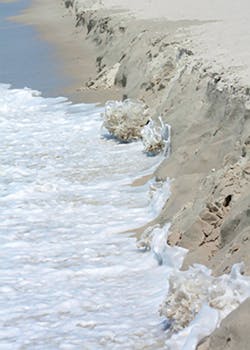Editor’s Comments: Consensus at the Water’s Edge
All of us have heard the debates-or participated in them-about the value of beach nourishment projects to slow erosion and safeguard coastal homes and infrastructure. Another discussion is brewing, though, that’s likely to become just as important: the valuing of individual property and the need for community consensus on large coastal protection projects.
A July article in The New Yorker looks at development along the New Jersey shore and explores the pros and cons of nourishment-adding sand from a source such as offshore dredging-as a way to preserve beaches and protect property from storms like Hurricane Sandy. The article includes a story from the small town of Harvey Cedars, NJ, which-feeling vulnerable to storm damage even before Sandy-opted to have 2.7 million cubic yards of offshore sand to be pumped onto its beaches to create 22-foot-high dunes, large enough to withstand the waves anticipated from a 100-year storm.
The work was carried out by the Army Corps of Engineers and paid for mostly with federal funds, so the question of who should pay wasn’t at play here as it has been in some recent cases. Most of the town’s residents readily signed easements allowing the Corps and the state access to their property to build and maintain the dunes. But a few homeowners objected, saying the dunes would block their ocean views. Eventually, with only 12 owners refusing to sign the easements-without which the project could not go ahead-the town invoked eminent domain on the grounds of public safety, and the dunes were built in early 2010.
After the project was completed, one family went to court to recover the reduced value of their home; they claimed that the $1.9 million property had lost $500,000 in value when it lost its ocean view. A jury eventually awarded the family $375,000. (In a somewhat similar Florida case in 2010, the US Supreme Court ruled that homeowners did not have to be compensated for their loss of exclusive access to the water.) When Hurricane Sandy hit Harvey Cedars in October 2012, the dune in front of the home was completely destroyed, but the house was safe-in other words, the dune had performed as intended.
The Harvey Cedars case encapsulates many of the issues that we’re likely to see repeated in the coming months and years as coastal communities try to decide how best to protect property and infrastructure.
Large projects like beach nourishment-or seawalls and other structures, for that matter-are pretty much all-or-nothing propositions; they don’t allow for dissent from individual property owners in their path. What obligation does a city or state have when property owners don’t agree? When is the use of eminent domain justifiable? Tell us your thoughts below, or e-mail, mailto:[email protected].
About the Author
Janice Kaspersen
Janice Kaspersen is the former editor of Erosion Control and Stormwater magazines.


